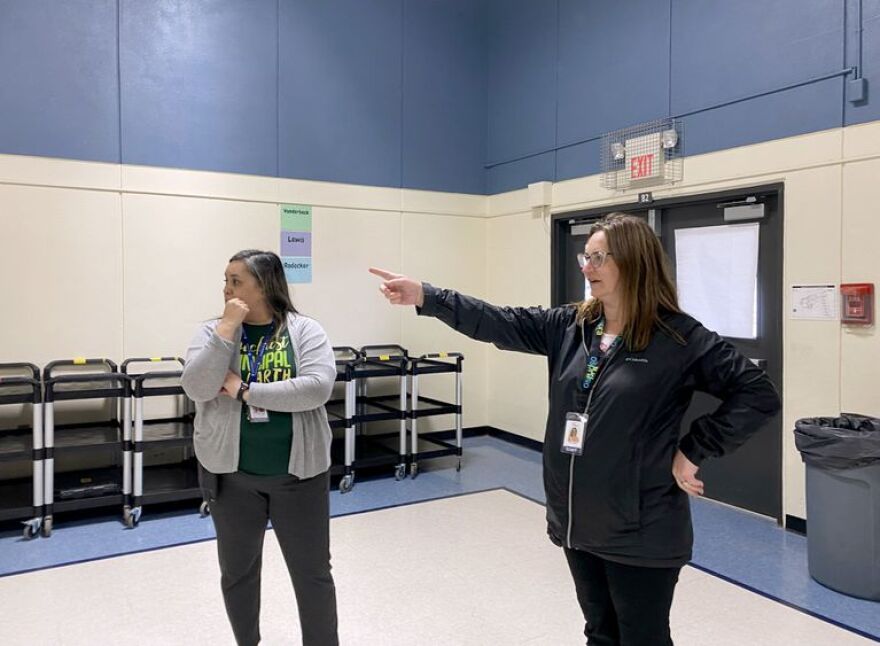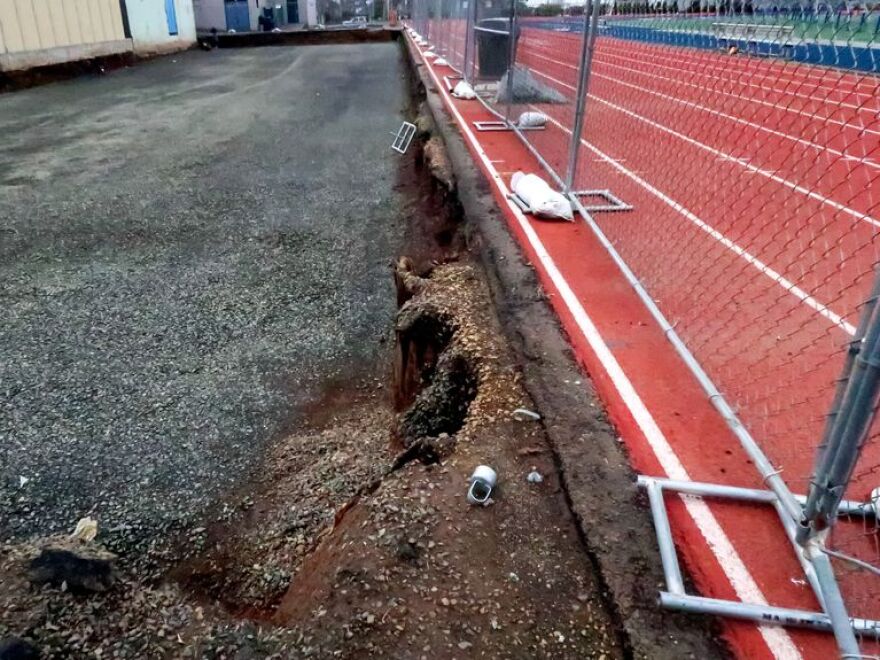Principal Kristin Tocano Becker never thought she’d see the day her school would get a new gym.
“It’s not a thing I thought I would see completed in the time that I anticipate working,” Tocano Becker said.
The current gym at Yaquina View Elementary, part of the Lincoln County School District, actually doubles as a cafeteria.
“Because we need the cafetorium for PE and indoor recess space, our kids, pre-COVID, were eating in classrooms because there wasn’t a dedicated space for them to eat,” Tocano Becker said.
Even the ability to hold indoor recess is limited by the size of the gym; teachers roll carts full of board games into their classrooms because there isn’t room for everyone in the gym.
Early in the pandemic, the state’s six-foot social-distancing rule meant only 20 children could be in the gym. Still, Tocano Becker wasn’t sure a new gym was possible.
“It’s millions of dollars, and that’s not easy to come by,” she said.
But now, this fall, Yaquina View will have a new full-size gym, paid for by $3 million in federal funds from the American Rescue Plan.
Districts across Oregon are required to spend some of their new, one-time, federal funds from the American Rescue Plan, also known as ESSER III, on addressing learning loss. But there’s no real requirement for the rest of the money.
That leaves school leaders with a lot of money to spend on almost anything, as long as it connects to the pandemic. Nurses, staffing wellness programs, communications staff, port-a-potties, playgrounds and buses are all ways they’re planning to use their federal dollars.
At the same time, these dollars give some districts, especially smaller ones, an opportunity to address long-standing problems while also responding to the pandemic.
In Lincoln County, district officials plan to use federal dollars on targeted intervention and extended learning opportunities, similar to other districts, to support students who may have fallen further behind during the pandemic.
“Not all students have the same level of incomplete learning. Students are already receiving assistance from their teachers during the typical class day,” said Lincoln County School District Business Services Director Kim Cusick in an email to OPB.

“However, for those students who need additional support, we wanted to provide extra learning time after school and during the summer,” Cusick said.
Lincoln County will also use some of its funds to replace lost Chromebooks, textbooks and library books.
District officials estimate they’ve lost 350 Chromebooks, 266 elementary school textbooks and almost 1,000 library books.
North Marion, Newberg and Pendleton school districts have also outlined plans to purchase Chromebooks with the federal funds.
Districts prioritize federal dollars for long-needed construction projects
But some spending items may seem less closely tied to the pandemic, though school officials insist they’re important investments. Lincoln County officials will use $2 million in ESSER III funds to replace and rebuild new grandstands at Newport High School.
“The previously existing grandstands at Newport High School were the only covered, on-site location that met the open-air space definition but could only be used in dry weather due to their dilapidated condition,” Cusick said.

Cusick said that in turn limited space for some electives and other class activities.
Oregon Department of Education Director Colt Gill said most school districts are planning to spend federal dollars on capital improvement projects, similar to the one in Lincoln County.
“Overall, we saw about 60% of the plans had some kind of capital expenditures in them,” Gill said. “About 50% of plans, those capital expenditures were based on the health and safety aspects.”
Districts have plans to make updates to outdated HVAC systems, a reflection of national trends in spending. Burbio, a digital platform tracking ESSER III spending in thousands of districts across the country, found over 40% of districts with planned spending on HVAC.
In Oregon, if a capital project costs more than $5,000, it needs approval from ODE. So far, 650 projects have received approval to use ESSER II or ESSER III funds across more than 140 school districts and education service districts. Only a few projects have been denied.
Gill said the federal funds give cash-strapped districts a chance to make long-needed improvements.
“We’re also in a state that has a lot of districts that have a long time deferred maintenance on things like HVAC and school kitchens, and so there were needs for upgrades before COVID-19 came, and this has, in many ways, exacerbated that need,” Gill said.
‘Not all districts are created the same’
Mark Witty, superintendent of Eastern Oregon’s Baker School District, said the needs and capacity can vary a lot in different parts of the state.
“I would get a little jealous when I’d go, say, to a Central Oregon school or one on the I-5 corridor, wherever, where the economy is booming and they have the capacity to do these types of improvements,” Witty said.
Smaller, more rural school districts don’t have as big of a tax base as more urban districts.

“Not all districts are created the same,” Witty said, “as far as their access to revenue or revenue sources to be able to make the upgrades.”
Voters in Baker did pass a school bond in May 2021. According to the Oregon School Boards Association, the district hadn’t passed a bond since 1948.
Witty said the bond, along with federal and state funding sources like the student investment account, will help pay for security upgrades and better air filtration to help current and future students.
“It’ll be a huge plus for us, yes for COVID but quite frankly the flu or whatever other viral infection that’s going around,” Witty said. “This will allow us to have a much better air quality within each of our classrooms.”
Baker has received ODE approval to use federal funds on other capital projects too — including a dishwasher, a bike trailer and stage curtains.
“Those kinds of things matter over time, and so you have to take pride, and you want to create an environment students and staff want to be in,” Witty said.
For a district like Baker, federal and state funding help modernize schools and provide a safe and engaging environment for students and staff.
“We were already super challenged because of the pandemic but those funds have really been able to allow us to leverage systems, approaches to be able to serve all kids,” Witty said.
“We needed those monies and we’re trying to leverage them to the best we can — not only for serving the student today but also trying to figure out how we can serve students in the future.”
But not everyone wants to be in a physical classroom. So some of the same districts investing in physical spaces are investing in virtual ones, too.
That includes Lincoln County and Baker.
“Many families have determined that online, asynchronous education is the way they would like to continue to stay,” Witty said. “So we now have platforms to be able to serve all family needs, whether they want synchronous education, asynchronous or a hybrid between the two.”
Lessons learned from the pandemic
Several districts are using ESSER III dollars to build up online programming — through staffing or online platforms.
Portland Public Schools, Oregon’s largest district, plans to invest $7 million in its online learning academy, a new program this school year.
In its first year, PPS Deputy Superintendent of Instruction and School Communities Cheryl Proctor said 600 students enrolled in OLA.
“We found that we were basically over-enrolled for what we were budgeted for and have had to expand on the online learning academy, requiring additional teaching staff,” Proctor said.
“One of the things that comes out of this is that reaffirmation that students learn and thrive in different environments,” said PPS Chief Financial Officer Nolberto Delgadillo.
“Whether it’s through a community-based organization or one of our high schools or thinking about what the virtual learning environment could be and the online learning academy can be moving forward, I think it’s one of the exciting things … coming out of the pandemic.”
Also included in several district plans: efforts to retain staff through financial incentives, wellness programs or COVID-related leaves. Director Gill said ODE is connected to maintaining the educator workforce.
“Any business owner or operator in Oregon understands how challenging it is to maintain a strong workforce right now with a strong morale,” Gill said. “We have all kinds of challenges for our school staff who have been working many, many hours to keep in-person learning going … in some cases feeling like they’re putting their own personal health at risk, being in an enclosed space with a number of students every day.”
Gill argues it’s important to support teachers’ health and safety as a way to maintain the educator workforce.
“Caring for teachers is an important part of this and finding the right ways to get teachers what they need, despite having these teaching shortages,” said Education Northwest Chief Program and Development Officer Jessica Johnson.
Foundations for a Better Oregon Director Whitney Grubbs said schools making changes — from how teachers communicate with families to online learning — are some of the less visible ways the pandemic has changed things in education.
“I think it’s opened up minds and we might crave a bit of kids walking down the street and going into the building,” Grubbs said. “But that, the inner workings of things and the possibilities have changed. I’m pretty hopeful about that.”
Copyright 2022 Oregon Public Broadcasting



